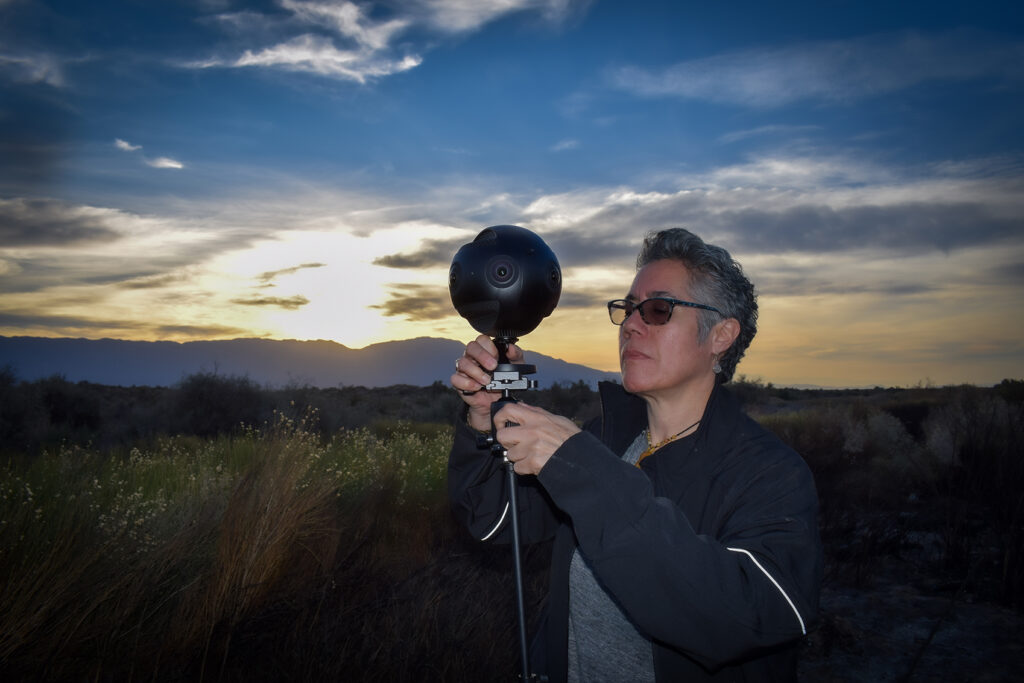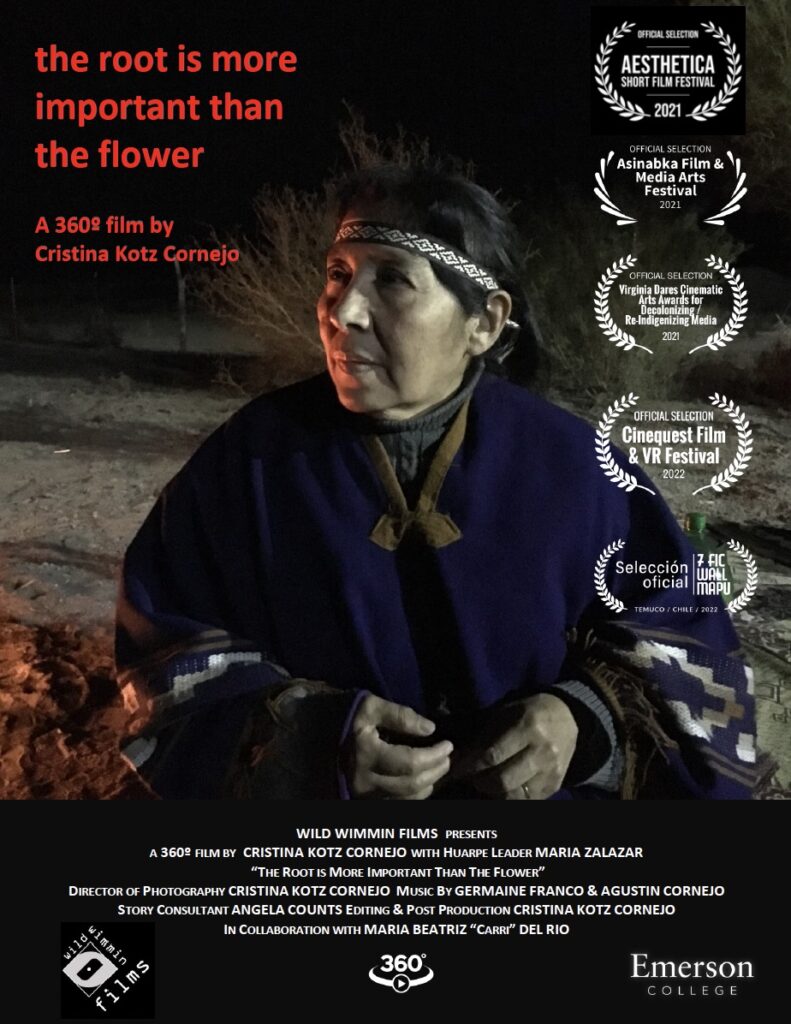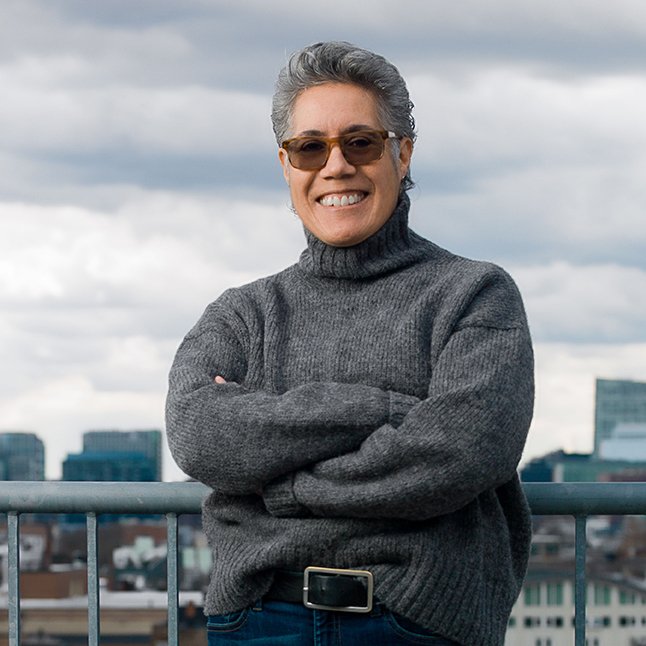Cornejo Returns to Her Roots with 360-Degree Doc

Visual and Media Arts Professor and Chair Cristina Kotz Cornejo stepped both into the future and the past with her latest film, la raíz es mas importante que la flor (the root is more important than the flower).
The documentary short was shot in 360-degree video, a virtual reality-adjacent technique that puts the viewer in the center of the shot, and it explores Cornejo’s family’s Huarpe roots in what is now Argentina.
The film has been screening at festivals in North and South America and Europe, taking home a Special Mention in the Arts and Narrative category at the Indigenous Film and Arts Festival of WALLMAPU in Temuco, Chile, and securing a finalist spot in Cinequest’s VR competition. This summer, it heads to New Zealand for the Maoriland Film Festival, the largest Indigenous festival in the Global South.
Emerson Today asked Cornejo about the film:

What does the title of the film refer to?
The title refers to the importance of our ancestry and where we come from — how our ancestral roots inform who we are today and give us the confidence to move toward the future.
What was the inspiration for the film?
I grew up hearing stories about my grandfather, who I never met and who came from very humble beginnings in San Juan, Argentina. He became a highly-regarded musician, eventually ending up in New York City in the 1930s and recording for Columbia and RCA Records, and performing in various Paramount Pictures movies with Tango icon, Carlos Gardel.
He was also Huarpe, an Indigenous people from the Cuyo region of what is now Argentina. His story always made me wish I had known him. As I grew older, the pull to know him got more intense. Being a filmmaker and artist, I was inspired by his roots, and I wanted to trace mine back to his. I feel like I have a lot in common with him.
In this journey, I came to meet and know a wonderful Huarpe community in San Juan: the Huarpe Community Cacique Colchagual and their leader, Maria Zalazar. I was invited to learn their histories and their connections to this region and eventually they welcomed me into their lives. To me, they’re family now. I feel my grandfather brought me to this beautiful moment and continues to guide me in this journey.

After I began experimenting with 360-degree filmmaking here in the States, I decided to take my Insta360Pro camera to Argentina. Eventually I filmed enough footage to teach myself how to edit this immersive material in Premiere Pro. After trying different techniques and storytelling devices within the 360 space, I began sharing rough cuts of the short film and I was encouraged to finish it.
I never really imagined that it would have a festival run or that it would be seen outside my small circle of friends, which included Maria and her community. But last year during the pandemic, I decided to record the narration in Spanish and English with the ever gracious and talented sound engineer, Pierre Huberson, who also happens to be [Media Technologies and Production]’s post-production manager. Once that was completed, I decided to submit to some festivals that program immersive content.
Can you explain what 360-degree video refers to and how it’s different from virtual reality?
360-degree video has a 360-degree field of view, so you can look all around and up and down. Essentially, the viewer is transported into the center of the action and can see everything. Some people refer to this as virtual reality too, but for me, VR is more than just 360-degree video, it’s a form that allows a more immersive experience, including 3D animation, interactivity, and other more sophisticated techniques beyond 360 video.
I am in development on a VR project now called Magic in the Desert that will utilize many different techniques and will also allow the participant to have agency in the story and to interact with objects. VR is very liberating in that way, and affords the ability to do things that are not possible in traditional 2D filmmaking, or even 360 filmmaking.
Why did you choose to film in this format? How does it change the storytelling?
I chose the 360-degree technology because I wanted to transport the viewer to Argentina and to San Juan and to the middle of the action. I wanted the viewer to feel like they are right there, that they are visiting Argentina and that they are meeting everyone in the story, face to face.
This technology is not for every story, but some stories are very suited for this format — this one is perfectly suited. It changes storytelling in that it is yet another tool in the toolbox that can serve the right ideas.
Were there challenges in making the film, either due to the pandemic, access, etc?
I shot it before the pandemic so I didn’t have that as a challenge, but the format itself has its challenges. Because of its 360-degree field of view, anyone who is not wanted in the shot has to find a place to hide, and in an open field it can pose challenges, so you get creative or you plan in advance where everyone will hide themselves. The other challenge for me was editing, but this challenge was only because I was learning something completely new.
Access is definitely the biggest challenge. Most people don’t own headsets to watch this format. And while the film has been playing festivals, people have been asking where they can view the film. While streaming online is viable for regular films, it is not optimal for 360-degree. To view it online you can scroll around with the cursor, but that doesn’t fulfill the point of filming in 360. I want people to see everything in the headset and be in the spaces I filmed, so access does pose an exhibition problem.
Can the Emerson community see it anywhere?
Not yet, it is playing festivals. In November, it premiered in the UK at the Aesthetica Film and Media Festival, and in Canada at the Asinabka Film Festival. Last month, it played at the Indigenous Film and Arts Festival of WALLMAPU in Temuco, Chile, and received a special mention. It’s also a finalist in the VR competition at Cinequest. I will be ready to show it after this summer.
Categories